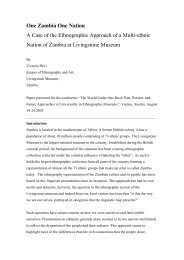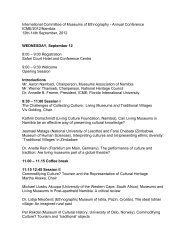Putting Museums on the Tour... - ICME
Putting Museums on the Tour... - ICME
Putting Museums on the Tour... - ICME
You also want an ePaper? Increase the reach of your titles
YUMPU automatically turns print PDFs into web optimized ePapers that Google loves.
2 of 5<br />
However, in ec<strong>on</strong>omically poor countries, especially third world countries, funding of museums is not a priority.<br />
Governments may recognise <strong>the</strong> need to fund museums but <strong>the</strong>y do not take priority over health, educati<strong>on</strong> and o<strong>the</strong>r social<br />
services. As such, <strong>the</strong>y are often under-funded. Fur<strong>the</strong>r, in ec<strong>on</strong>omically c<strong>on</strong>strained countries even local companies and<br />
individuals do not have enough to spare to help fund museums. Such museums <strong>the</strong>refore struggle to survive <strong>on</strong> <strong>the</strong> little<br />
government funding, erratic d<strong>on</strong>or funding, and small amounts of income generated from entrance fees and o<strong>the</strong>r services<br />
and products. As Camara (1992) states, "Financial problems are a major c<strong>on</strong>cern for most African museums due to <strong>the</strong><br />
absence or reducti<strong>on</strong> of <strong>the</strong> operating budget."<br />
With c<strong>on</strong>tinuous under-funding, such museums fail to carry out useful research or to maintain <strong>the</strong>ir exhibits. They become<br />
mere galleries, which are not dynamic and are poorly maintained. Visitors still come, but <strong>the</strong> quality <strong>the</strong>y receive is not as<br />
good as it should be, and <strong>the</strong>y do not see any significant change if <strong>the</strong>y return some years later. C<strong>on</strong>sequently, such<br />
museums are slowly "dying".<br />
What is <strong>the</strong> soluti<strong>on</strong>? Government funding is unlikely to increase unless <strong>the</strong> ec<strong>on</strong>omy improves. Private funding is<br />
unreliable. Can tourism be <strong>the</strong> answer?<br />
Can tourism sustain <strong>the</strong> museums?<br />
Using Livingst<strong>on</strong>e Museum, Livingst<strong>on</strong>e, Zambia, as a case study, just over 1% of <strong>the</strong> museum income requirement is<br />
raised through entrance fees, as can be seen in table 1.<br />
Table 1: Comparis<strong>on</strong> of Budget Estimate for Livingst<strong>on</strong>e Museum with Income raised from entrance fees<br />
2000 2001 Average<br />
Total Budget Estimate for Livingst<strong>on</strong>e Museum (excluding<br />
capital budget)<br />
K1.72 billi<strong>on</strong> K2.53 billi<strong>on</strong> K2.12 billi<strong>on</strong><br />
Total income raised through entrance fees K29 milli<strong>on</strong> K32 milli<strong>on</strong> K30.5 milli<strong>on</strong><br />
Income raised from <strong>Tour</strong>ists as a Percentage of Budget<br />
Estimate<br />
1.7% 1.3% 1.44%<br />
Source: Livingst<strong>on</strong>e Museum<br />
Statistics also show that just over 1% of foreign tourists entering Livingst<strong>on</strong>e area enter <strong>the</strong> Livingst<strong>on</strong>e Museum (Ministry<br />
of <strong>Tour</strong>ism, 2000; Ministry of <strong>Tour</strong>ism, 2001; Livingst<strong>on</strong>e Museum, unpubl. visitor statistics).<br />
Comparis<strong>on</strong> of foreign tourists entering Livingst<strong>on</strong>e with visitors entering <strong>the</strong> Livingst<strong>on</strong>e Museum<br />
1999 2000 Average<br />
No of visitors entering Livingst<strong>on</strong>e area via Victoria Falls, Kazungula and<br />
Katima Mulilo border posts and Livingst<strong>on</strong>e Airport<br />
214,430 228,743 221,587<br />
No of foreign visitors entering <strong>the</strong> Livingst<strong>on</strong>e Museum 2,525 3,532 3,029<br />
Percentage of foreign tourists entering <strong>the</strong> area who visit <strong>the</strong> Livingst<strong>on</strong>e<br />
Museum<br />
1.2% 1.5% 1.37%<br />
Source: Ministry of <strong>Tour</strong>ism<br />
In o<strong>the</strong>r words, if all <strong>the</strong> tourists currently entering Livingst<strong>on</strong>e area could be persuaded to visit <strong>the</strong> museum, <strong>the</strong> museum<br />
could be totally funded by tourism.<br />
However, this is not practical for various reas<strong>on</strong>s. Firstly, tourism is an unpredictable business because it relies <strong>on</strong> various<br />
factors including immigrati<strong>on</strong> policies, infrastructure development and political stability. For example, <strong>the</strong> volatile<br />
political situati<strong>on</strong> in Zimbabwe has had a big impact <strong>on</strong> neighbouring Zambian tourism. There was a significant drop in <strong>the</strong><br />
number of foreign visitor arrivals in <strong>the</strong> 1970's during <strong>the</strong> freedom struggle in Zimbabwe. After Zimbabwe's independence<br />
Zambian tourism improved drastically (Ministry of <strong>Tour</strong>ism, 1985). The recent political situati<strong>on</strong> in Zimbabwe has also<br />
had an impact <strong>on</strong> Zambia's tourism. Internati<strong>on</strong>al crises, such as <strong>the</strong> terrorist attacks <strong>on</strong> USA in September 2001, can also




